Many of us recognize the Russian Blue cat breed at the first sight of one. A medium-sized cat breed with a bluish gray coat and majestic emerald green eyes, the Russian Blue is a sight to behold. I’ve had the opportunity to see a purebred once at a cat show, and boy, are they simply stunning.
It comes as no surprise that the Russian Blue cat breed hails from Mother Russia, but what other things do you know about these “blue” Rusky felines? Check out our fun list of facts about the Russian Blue cat breed.
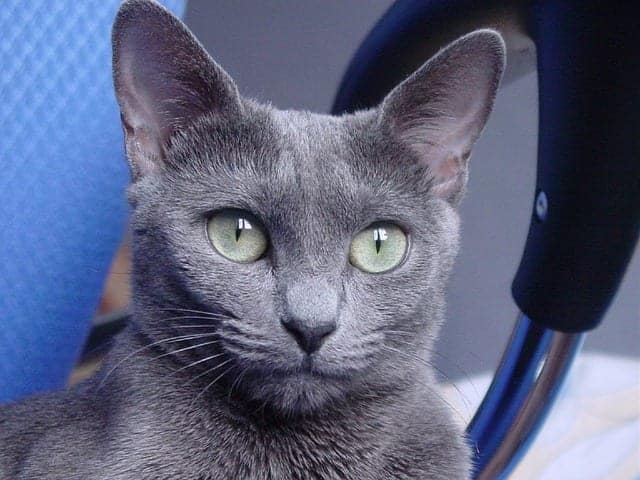
They’re Not The Only “Blue” Cats In The World
Although the Russian Blue is the only cat breed that has the word “blue” in its name, the Chartreux cat breed of France is also synonymous for that blue hue that many of us cat lovers admire. While the Chartreux is considered to be a rare cat breed, the Russian Blue can be found in abundance. But there are actually two other breeds that are “blue” as well, the Korat of Thailand and the British Shorthair. The Russian Blue is physically in the same class as the Korat and Oriental Shorthair: long, slender, elegant. As you see from the image below, the Chartreux has a head and frame that is larger than that of the Russian Blue.

A Chartreux cat
Fun Russian Blue kitten cat fact: Unlike most kittens born with blue eyes, the Russian Blue has yellow eyes at birth, and by four months there is a bright green ring around the pupil.
A Royal Favorite
Although the exact origin of the Russian Blue cat breed is unknown, it is believed that the Russian blue originates from northern Russia, specifically the Archangel Isles. Many believe the Russian Blue is a natural breed originating from the Archangel Isles in northern Russia, where the long winters developed a cat with a dense, plush coat. It is rumored by many that the Russian Blue was a favorite among royalty, the purrferred breed of choice for the powerful Russian czars of the past.

Legends of folklore claim that once a Russian Blue healed an ailing prince, while many were believed to have been used in royal settings to ward off evil spirits from harming the royal newborn babies. Because of their widespread popularity in the royal realm, these cats are thought to be of royal lineage pedigrees. Oh la la!
Quite possibly the cutest little fun fact about the Russian Blue Cat Breed: The Russian Blue is well-known for its “smile.” It has a slightly upturned mouth, which is frequently compared to the enigmatic Mona Lisa smile.

Their Lovely Blue Coat is More Special Than You Even Realize
Although the Russian Blue has a short coat, it is thick and dense, which helps them adapt to the frigid Russian climate. And although their coat is short and thick, they shed very little. Because of their thick, lush coat, the Russian Blue appears larger in size than they actually are. What’s even more interesting is that the Russian Blue cat breed tops the list of “hypoallergenic” cat breeds. While it’s true that no cat–or even dog for that matter–is truly “hypoallergenic”, it is true that Russian Blue cats have lower levels of Fel d 1, the protein in cat saliva and skin secretions responsible for your itching and wheezing.
Pawsome Russian Blue paw fact: Despite the fact that their noses are dark gray or black in color, their paw pads are pink.
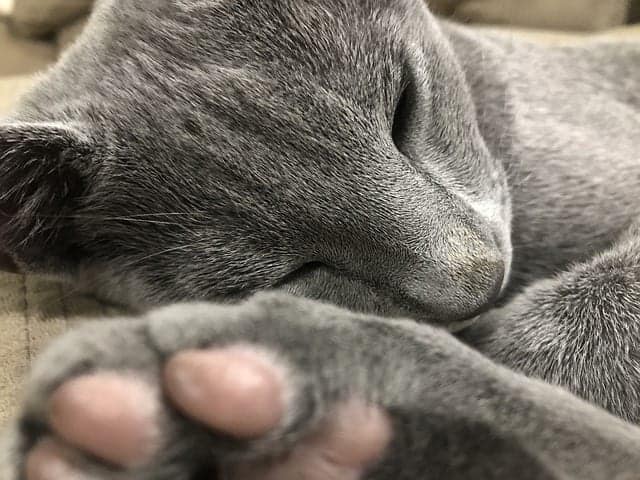
A Cat On A Strict Schedule
The Russian Blue is a cat that sticks to their traditions and rituals. For example, you get your Russian Blue cat accustomed to having their breakfast at 7AM sharp each morning. You BETTER be purrpared to stick to this feeding time! The Russian Blue is meticulous in all things grooming, and rather particular about their purrferred feeding time–as well as favorite human. They are a highly intelligent cat breed that prides themselves on a strict schedule. And don’t think twice about letting their cat litter box get messy, they won’t have that. They’re vocal like their distant cousins, the Siamese, too. They’re sure to give you an earful of disapproving meows about it should it not meet their high standards.
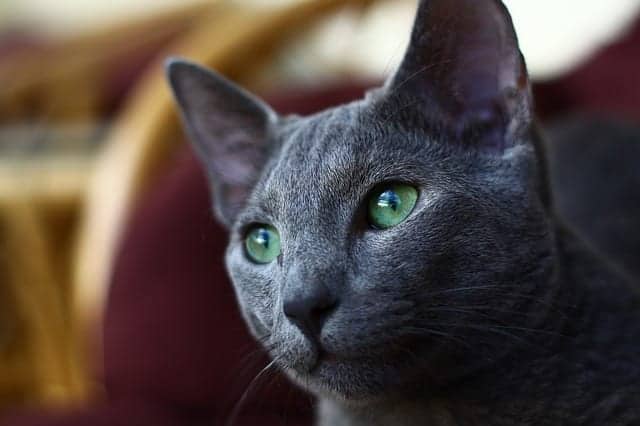
A Brief History Of The Russian Blue Cat Breed…
The breed made the trip from Russia to Great Britain sometime in the mid-1800s, likely brought by sailors. Though the Russian Blue first appeared at the Crystal Palace in England in 1875, its development was limited to Scandinavia and Russia until after the Second World War. During this time, it was interbred with Siamese cats. After the war, the breed made its way over to the United States. Today, most of the Siamese has been bred out.
Impressive Hunter
If you have a Russian Blue in your life, you should be able to attest to their superior hunting abilities. That is, should you allow your Russian Blue to travel outdoors. Their distinctive hunting instincts can also be seen elsewhere. Their intense play and thrill of “hunting” and chasing their favorite toys is present as well. The Russian Blue is also known for being easy to train, loving to learn new tricks!
As Sweet As They Are Soft
The Russian Blue might be a fierce hunter–whether it’s over a real mouse or a toy mouse. But they are undoubtedly sweet to the people that they most care about. This cat breed is often reported by their owners as being clingy. Many even follow their owners around the house! While they are needy in your presence, they do fine when left alone for longer periods of time. Reportedly though, they shy away from strangers and new faces they aren’t familiar with.
The Russian Blue cat breed is said to be a healthy cat breed. Naturally occurring, they have an impressive lifespan of 15-20 years–probably thanks to good old genetics and not human intervention! I can only hope that one day I can find one of these breeds at a rescue or a shelter. Because although I find them lovely, I could never buy a cat and forgo a shelter/rescue pet missing out on their second chance at life.
Do you have a Russian Blue in your life? Share your photos with us in the comments!
REMEMBER: ADOPT, DON’T SHOP; FOSTERING SAVES LIVES & SPAY AND NEUTER!



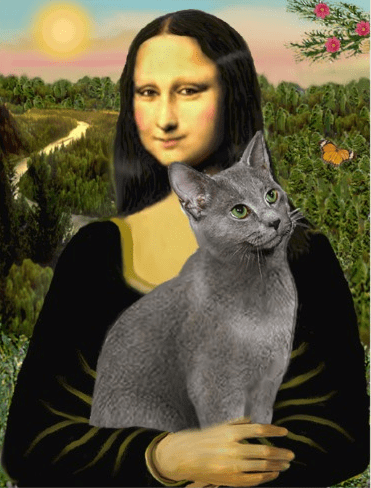




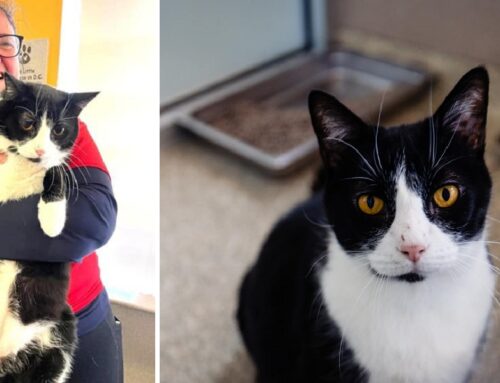

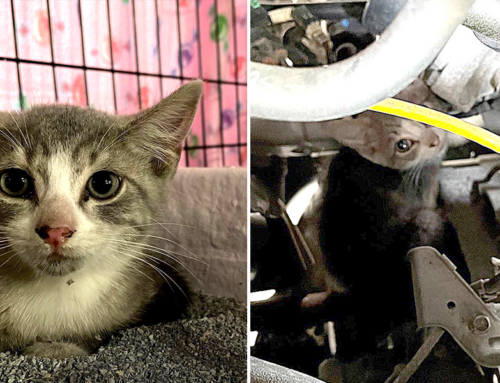

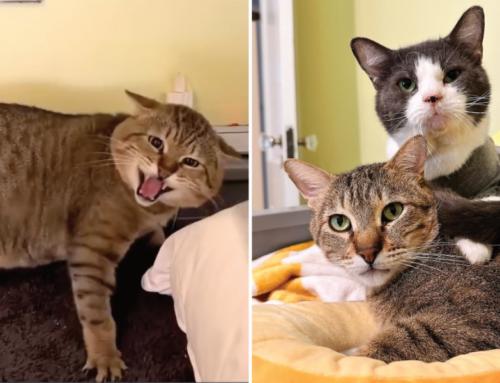
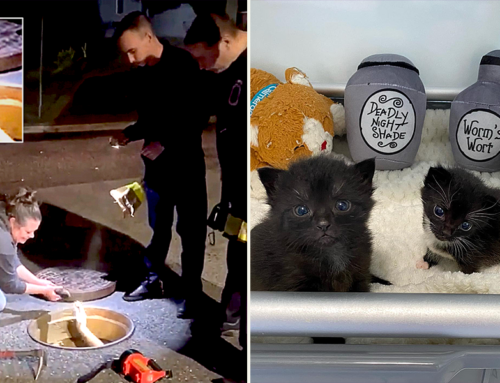
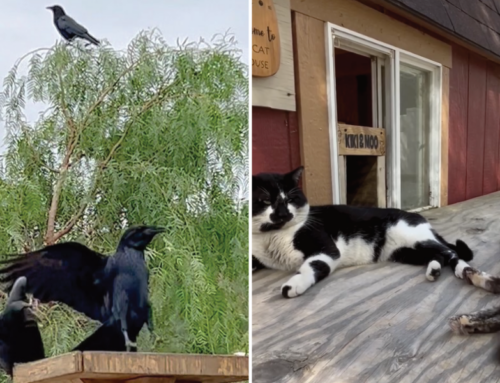
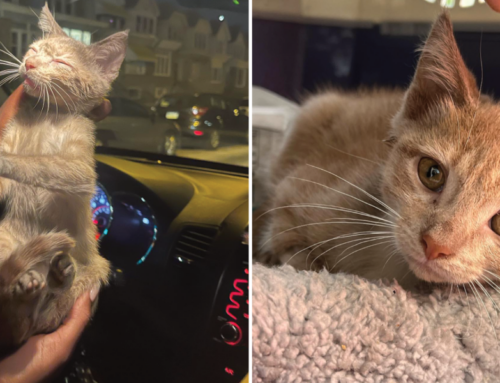
Love my blue..and she was a shelter/foster pet. Mant blues are available..if you can’t find one try petfinder.com
“NATASHA” – GOT HER AT A SHELTER – SHE IS ENJOYING BEING OUT OF THAT CAGE { TRIED TO POST A PHOTO BUT WAS UNABLE }
My daughter rescued a blue from her work and as she was up to 5 rescues I was the lucky one.My Winston fits all the points you made in the story.Hope you get lucky in finding one
Incredible on how this article is right on it. we unfirtunately made the mistake of feeding our blue at 6h30 AM… well guess what. we now are getting up at 6h30 everyday..and forget about not doing it. he will make you wake up and his litter better be cleaned daily….. else you’ll will hear from it.. but aside from this it is the most playfull and fun cat I have ever had. Always following us around, greeting us at the door and all.. we even taught him a few tricks that usually dogs are doing ! (it takes a lot of patience thought..lol).
I have had 3 Archangel Blues in my life. All three have turned up to live with each household out of the ‘Blue’.
Lady came to my cousin and stayed for a number of years.
One day a boy appeared at a house where my friend worked as a carer. Mr Pushkins was very friendly and an adventurer. He also lived with me for the last three years of his life.
Spook turned up on my doorstep one night and stayed the night. He left in the morning but I saw him a week later and he decided to stay. He would follow me everywhere even sitting on the edge of the bathtub while I showered.
They hate loud noises and love running water. Both boys would wander around in the rain.
Little Blue is our Russian Blue. We were gifted with her from a friend who couldn’t keep her. I agree with everything above except the non-shedding. Blue sheds like a fiend! She is a sweetie though and we adore her!
Wish it would let me leave a pic, cause I Love to show off my baby! He’ll be 14 in 5 days, and although I know he’s not a full Blue, you can’t tell that by looking at him. His mom was a calico. All that was said in the article pertains to Jack, except the sweet part. He’s got a bit ( ok more than a bit ) of a bad attitude. Not a people person at all. He likes me, and puts up with a few other people in my life, but that’s it! I’ve Loved him from the get, and will continue to long after he’s gone, which I pray won’t be for a very long time!
We found our Blue at the airport when he was about 8 weeks old. Don’t know his story. He was just found wandering around. We couldn’t just leave him. He was so tiny and now just about runs our home. Very vocal.He’s very skittish around anybody but us. Not taking too well to our new cat, either.
My cat, Spooky, is a Russian Blue mix and almost all of the above describes him perfectly! The only differences for my sweet boy is that his paw pads are black, he sheds a lot, and he has yellow eyes with a ring of green around the pupil. I enjoyed learning about his heritage in this article, thank you for sharing. 🙂
My Pablo has been our joy for nearly two years now and he’s exactly as described. We were lucky enough to get him from a rescue shelter at 8 weeks and we’ve loved him ever since. ?
Our Blue, Gary, bc he sounded like the snail on SpongeBob, would follow my hubby around. When he couldn’t find him he would run around the house saying, what sounded like “mom”. He slept on top of my husbands head even! We would take him out with a harness and let him climb the small tree in the yard or jump like 6′ high to catch a moth! He was always climbing. We would find him hanging on the sil to the front door window, 5′ in the air, just looking outside lol he was an amazing and beautiful boy!
I love cats!
After several years of not having a feline friend in my life, I felt it was time once again to have a little room mate. After much research I decided I wanted a Russian Blue. So the search was on and after just a few short weeks I found an ad posted by a local government run animal shelter. That very day I went down to the shelter, not knowing what to expect. It only took a second of meeting her to know We were meant for each other. When doing the paperwork for the adoption, I found out that I came to her rescue just in the nick of time because she was scheduled to be euthanized later that week. I’ve had her for nearly a year now and can’t imagine my life without Gracie!
DerikLattigCats says this was a great read. I had a Russian Blue at one time and she was great.
I have had Russians since 1979. There is nothing like the love, intelligence & sweetness of a purebred Russian. We just celebrated our Nikolai’s 16th birthday with an inscribed Blue Velvet cake, and he enthusiastically demolished his pieces, and knew it was for him.
I had a Russian blue cat as a child. Misty lived to be 18 years old. Actually we didn’t know what breed of cat she was at the time. She was one of many kittens in the country at my uncle and aunts house. We took her home and she was a fantastic pet. She would follow me around the house. She definitely knew it was time to eat. She would watch TV with me and sleep with me at night. She also was an excellent hunter. I cri so when she died. I still miss her.
Our Russian Blue is a rescue shelter kitty. We adopted him with the name Keith and I renamed him Satan, because of his high energy, intelligence, stalking and catching prey, and he likes to attack for no reason especially his big sister which is a little Shih-poo. Their about the same height but the dog weighs more. He’s an awesome kitty, the only thing that doesn’t match up is he’s not a loving cat, but we all have personality flaws.
I agree with the breed’s characteristics. My Russian Blue, named Bleu, turned up living under my house crawl space battling the opossums at night. We took him to the vet for medical care and neutering and kept him inside with out other cats. He became the Alpha male.
He loved water and I’d have to push him out of the shower when I was in there. He loved walking on leash and harness especially at the beach and would play with the shallow waves. He was very dog like. Very friendly and loved attention from everyone except strangers who came to the house. Was highly protective of us and would deeply growl like a dog to strangers or animals that came near the house. He loved traveling with us, especially car rides! He even fetched balls and toys. And he was an amazing hunter! He lived till 23 and our mouse population grew after he passed away. No other cat has been able to keep their population down.
We miss him more than words can express;-)
I’ve had two Russian Blues in my life over the last 17 years. I was working as a home health aide and had a cat meow really loudly outside the door to the apartment my client lived in. This cat come to find out had been abandoned by his owners by accident when he accidentally escaped while they were moving out. He had been homeless ever since and it had been months. One of the old ladies was threatening him harm so that day I fed him and scooped him up and put him in my car and brought him home. I have no idea how old he was but Blue was a sweet guy. We loved him. He moved with us 3 times and each time we were packing to move he slept on the boxes so we wouldn’t “forget” him. The last time we moved we opened the cat carrier and he just walked in. He learned where we went so did he. I still miss him and he’s been gone for nearly 10 years now.
Our second Blue cat is named Grayson. He’s not a pure blue bc he has 2 tiny white spots. Everything else is exact except shedding both my blues were/are shedders. Grayson was born at our local Walmart out in the fixture cage. So let’s just say he was a “little” wild. He’s my baby though. He has his own chair and two pillows I named to go in the chair and a warm fuzzy blanket. He likes his own space to sleep bc he doesn’t want his belly rubbed. He’s very shy if he doesn’t know you. He sleeps on us at night and then will sleep on his shiny pink pillow I have under the bed for when the cats lay under it. (There are two pillows under the bed)
Both of my blues were strays or homeless when I got them. Our cats always find us. Otherwise we adopt. I have a 15 year old ginger who was adopted when he was either 3 or 6 months. Id have to pull out his adoption papers.
My Princess Blu is 8 years old. I’ve had er since she was 4 months old. My Companion Pet, my lil Sweetheart, my Joy! She’s a talker and Very Smart! My Love 💕
Today I adopted a teenage female Russian Blue from a local family who has to move out of her home. I’m so fortunate! She has no name yet, was never vaccinated nor nor microchipped. Walking thru the door to meet her she came right to me head butted my leg,. rubbing all over my feet n legs. She chose me. Shes s ol Nowhere jnder a yr old. I’m so thrilled. Tomorrow taking care of mher needed shots, microchipping.
Sweet, talks when I speak to her, using litterbox, what a Doll. Time to choose a girls name & get on with our feline lives..
My 14yr old son saved a Russian Blue kitten of 4weeks old from a shelter. Was so tiny & scared, slept alone & away from the other kittens. We did not know of this breed but so blessed to have him as an addition to our family. He has gained weight, love & lots of attention. Such a special breed & kitten. He is named Paris -after Paris of Troy.
Yes! My Smokie is definitely a Russian Blue! She trained me to play fetch (be prepared for a variety of toys to throw!) and will repeatedly bring the mouse/bird back to me proudly, play with it close to me while I pet and praise her, then after a minute, expects me to throw it again (rinse and repeat for like 20 minutes until you get tired!). She loves water and even loves to dip her legs and tail in the bathtub even after falling in twice when she wasn’t as coordinated!). She was very dark grey when I got her in 11/2021 at a few months old and now 4/2022 has a lot of streaks of silver and her snout/mouth/eyebrows and ears are mostly silver. She’s my ‘dog-cat’, besides playing fetch and loving water, she follows me everywhere. And she loves to eat – the Russian Blues adore food! and will constantly beg for food. Gonna have to try not to give in so much, she’s becoming round. But is also very long and slim other than the round tummy with very long legs. She also often looks at you at times with her mouth closed and tongue sticking out-cutest thing! She’s very loving and one of the most wonderful cats I’ve every had. Can’t go wrong with this maintenance free and lovable cat (grooms a lot and never had to learn about the litter box, which she loves and insists on using it while I am cleaning it!
We purchased a Russian Blue (Pandora is her name) from a shelter she was 3 mths old she will be 4yrs old on May 8th. She’s the most loving, intelligent feline we’ve ever had. Best decision we ever made.
We love our Russian blue my boyfriends sister had to move so we took her she’s been with us for 9 years now only pet and she can’t get enough love from us and we can’t get enough love from her!
Oh yea my Russian blues name is Bailey and she’s 17 and so healthy!